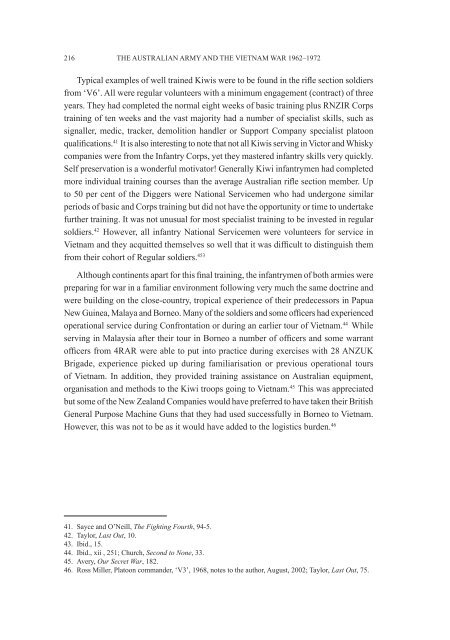conference proceedings - Australian Army
conference proceedings - Australian Army
conference proceedings - Australian Army
You also want an ePaper? Increase the reach of your titles
YUMPU automatically turns print PDFs into web optimized ePapers that Google loves.
216<br />
THE AUSTRALIAN ARMY AND THE VIETNAM WAR 1962–1972<br />
Typical examples of well trained Kiwis were to be found in the rifle section soldiers<br />
from ‘V6’. All were regular volunteers with a minimum engagement (contract) of three<br />
years. They had completed the normal eight weeks of basic training plus RNZIR Corps<br />
training of ten weeks and the vast majority had a number of specialist skills, such as<br />
signaller, medic, tracker, demolition handler or Support Company specialist platoon<br />
qualifications. 41 It is also interesting to note that not all Kiwis serving in Victor and Whisky<br />
companies were from the Infantry Corps, yet they mastered infantry skills very quickly.<br />
Self preservation is a wonderful motivator! Generally Kiwi infantrymen had completed<br />
more individual training courses than the average <strong>Australian</strong> rifle section member. Up<br />
to 50 per cent of the Diggers were National Servicemen who had undergone similar<br />
periods of basic and Corps training but did not have the opportunity or time to undertake<br />
further training. It was not unusual for most specialist training to be invested in regular<br />
soldiers. 42 However, all infantry National Servicemen were volunteers for service in<br />
Vietnam and they acquitted themselves so well that it was difficult to distinguish them<br />
from their cohort of Regular soldiers. 453<br />
Although continents apart for this final training, the infantrymen of both armies were<br />
preparing for war in a familiar environment following very much the same doctrine and<br />
were building on the close-country, tropical experience of their predecessors in Papua<br />
New Guinea, Malaya and Borneo. Many of the soldiers and some officers had experienced<br />
operational service during Confrontation or during an earlier tour of Vietnam. 44 While<br />
serving in Malaysia after their tour in Borneo a number of officers and some warrant<br />
officers from 4RAR were able to put into practice during exercises with 28 ANZUK<br />
Brigade, experience picked up during familiarisation or previous operational tours<br />
of Vietnam. In addition, they provided training assistance on <strong>Australian</strong> equipment,<br />
organisation and methods to the Kiwi troops going to Vietnam. 45 This was appreciated<br />
but some of the New Zealand Companies would have preferred to have taken their British<br />
General Purpose Machine Guns that they had used successfully in Borneo to Vietnam.<br />
However, this was not to be as it would have added to the logistics burden. 46<br />
41. Sayce and O’Neill, The Fighting Fourth, 94-5.<br />
42. Taylor, Last Out, 10.<br />
43. Ibid., 15.<br />
44. Ibid., xii , 251; Church, Second to None, 33.<br />
45. Avery, Our Secret War, 182.<br />
46. Ross Miller, Platoon commander, ‘V3’, 1968, notes to the author, August, 2002; Taylor, Last Out, 75.

















